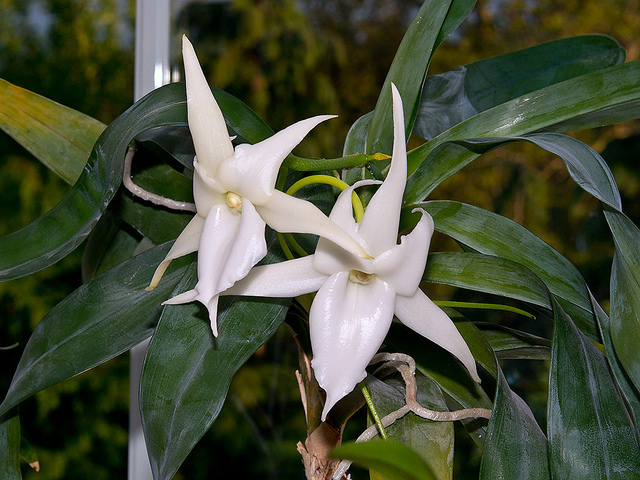(An-Gray-Eh-Come)
Subtribe: Angraecinae
Number of Known Species: 210
Native Range: Africa and Madagascar
Skill Level: Experienced
Good Introductory Species: Angraecum leonis, A. sesquipedale
Angraecums are marvels of coevolution. The oft-repeated story of Charles Darwin hypothesizing that the foot-long nectar spur of the Madagascaran A. sesquipedale had evolved along with a specific moth having a proboscis of similar length-and the subsequent discovery of just such a mothis certainly one of the most impressive accounts in the annals of evolutionary biology. Like almost all moth-pollinated flowers, Angraecums are glistening white to be clearly visible in moonlight, and to make sure no moth can pass them by, they become intensely and sweetly fragrant after sunset. Most have a long spur that curves and twists like a horn or tail behind the flowers. The moth’s sugary nectar reward is produced toward the bottom of this long spur. From our point of view, the spur adds enormously to the beauty of the flowers, which are star-shaped and fronted by a big lip that poufs out like a kerchief caught in a breeze. They have a certain kinetic balance to them, like a well-constructed mobile. Angraecums are monopodial orchids, with leaves zigzagging up stems that may be short and stout or thin and vinelike. Fat, slow-growing roots push out from the lower section of the stem and head into the air or across whatever substrate they happen to contact.
Angraecum scottianum
Several related genera are also worth seeking out. Aerangis (Air-Ang-iss) and Aeranthes (Air-Ant are very similar to Angraecuin in both culture and appearance.
CULTURE
To succeed with this genus, remember two things. Hirst, they relish warm, very humid conditions during spring and summer, with a slightly cooler and drier rest period in winter. Second, they are rather slow to reestablish after root loss caused by careless repotting or some other trauma. The first two plants I received were compromised from the start and very slow to recover, which-unjustly-gave me a bad taste for the genus until I tried again a few years later with healthy plants. You may have to pay a bit more for a well-established Angraecum, but you will not be disappointed. Many species are rather small, and they do very well in the humidity of a light box or enclosed room as well as a greenhouse; their need for humidity makes them a poor choice for a windowsill.
Aerangis rhodosticta
TEMPERATURE
Warm to intermediate (with an intermediate to cool rest in winter)
LIGHT
Somewhat bright (1,500-2,500 fc)
HUMIDITY, WATER, AND FERTILIZATION
Humidity should range from 70% to 90%. Since the roots prefer to run free on a mount or through the slats of a basket, Angraccums should be watered or misted almost daily. Give them moderate applications of fertilizer during the warmer months.
POTTING AND MEDIA
Though the large species, such as A. sesquipedale and A. magdalenae, are best potted in a coarse, loose mix (coarse bark or bark mixed with charcoal), many of the smaller species as well as the pendent or vining types are happiest mounted on a piece of cork or tree fern. Offsets can be removed and potted separately once they have at least three or four roots. Try to choose a mount that will allow for some growing room, as you should not disturb an established plant any more than necessary.


